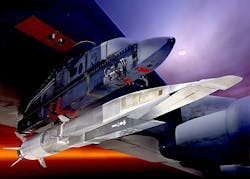Just in a nick of time: U.S. military researchers finally get serious about Mach 5 hypersonic weapons
The urgency with which military researchers are diving into hypersonic weapons technology indicates how much and for how long that military leaders have stood-by in hypersonics development -- particularly in anti-ship missiles -- while traditional adversaries have pushed forward quickly.
Hypersonic munitions are unlike any other weapon, in that they can move at Mach 5, or even faster. The central issue here is warning time. A missile traveling at five times the speed of sound is going about 3,800 miles per hour.
That's more than a mile per second. Target a ship at sea with such a hypersonic missile, that ship's crew has less than two minutes to detect, identify, and track the incoming missile, and then bring defensive weapons to bear and fire. Count to 105, and that's all the time that ship has to defend itself -- and only if it has sufficient sensors and weaponry, and only if everything works right; otherwise that ship is in big trouble.
I first started to notice about two or three years ago when I read about reported Russian and Chinese test flights of hypersonic weapons. In March 2016 officials of the Russian navy announced they had begun testing the hypersonic Zircon anti-ship cruise missiles, which are expected to reach five or six times the speed of sound. These tests indicated that the Russian military then was well along in developing hypersonic missiles primarily for anti-ship warfare.
A month later, in April 2016, China reportedly flight tested a new high-speed maneuvering warhead days after Russia carried out its own hypersonic glider test. Many of these maneuvering warheads essentially render ballistic missile -- and traditional ballistic missile defenses -- obsolete; no longer can defenders rely on a predictable ballistic trajectory to intercept incoming threats.
Around this time U.S. military officials were reporting progress on the Navy Lockheed Martin Long Range Anti-Ship Missile (LRASM), with barely a peep about hypersonics. Here's the deal: a hypersonic missile traveling at Mach 5 could read a target 20 miles away in about 21 seconds. It would take a subsonic LRASM more than four minutes to land an attack from 20 miles away. The LRASM is just no match for a hypersonic missile.
Viewed in these terms, hypersonic munitions are the weapons of the future, and it's clear that the U.S. military was caught with its pants down regarding this crucial future technology.
Related: Air Force doubles-down on hypersonic weapon development with second cruise missile contract
Now the Pentagon is making up for lost time by moving forward aggressively on hypersonics research by partnering with Lockheed Martin Corp. Earlier this month the Air Force Life Cycle Management Center at Eglin Air Force Base, Fla., awarded the Lockheed Martin Missiles and Fire Control segment in Orlando, Fla., a potential $480 million contract for Air-Launched Rapid Response Weapon (ARRW) critical design review and test and production readiness support.
Air Force officials say they want to achieve a capable weapon by 2021. The Air Force first awarded Lockheed Martin a contract last April to develop a prototype hypersonic cruise missile, the Hypersonic Conventional Strike Weapon (HCSW). That project could cost as much as $928 million over the course of its lifetime. It's probably just coincidence that Lockheed Martin is prime contractor for the LRASM anti-ship missile.
To be fair, U.S. military hypersonic weapons research didn't just start with the two contracts to Lockheed Martin this year. As far back as 2008 -- perhaps even farther back -- the U.S. Defense Advanced Research Projects Agency (DARPA) in Arlington, Va., and the U.S. Air Force were working on the Black Swift project to develop a hypersonic aircraft.
Related: Orbital ATK to help U.S. military develop hypersonic propulsion for aircraft and missiles
In early 2015 the Air Force Research Laboratory Munitions Directorate at Eglin Air Force Base announced the High Speed Strike Weapon (HSSW) program to develop a hypersonic munition able to attack and destroy targets quickly over long distances, and pose lethal threats to many different targets in many different locations all at the same time.
In June 2016 DARPA launched the Advanced Full Range Engine (AFRE) project to develop a full-scale reusable propulsion system for future hypersonic aircraft and missiles that can fly at least five times the speed of sound. The AFRE project started bearing fruit in September 2017 with a $21.4 million DARPA contract to Orbital ATK Inc. in Elkton, Md.
All this comes in a nick of time. Some of the world's first hypersonic weapons are expected to deploy as early as 2021.
Ready to make a purchase? Search the Military & Aerospace Electronics Buyer's Guide for companies, new products, press releases, and videos

